American Car Spotters Guide - 1950 |
|
|
 |
|
|
|
The 'Fifties were to bring even more drastic changes. America, as never before, moved out on the open road. New highway systems were conceived and constructed, bringing main cities and all states nearer to one another - and Americans, thanks to the freedom the automobile provided, began to discover their own country. Vacation trips became longer in actual distances covered and that meant more time spent in the family car. Interior comfort came to be of prime importance.
Due to general speed limits, active driving was never a major requirement, and underneath the then new sheet metal was a suspension system of the Nineteen-Thirties, with live-axle leaf-spring rear suspension, soft springing and damping. Seats didn't need to provide lateral support for fast cornering speeds since no one ever thought of cornering rapidly. They had, however, to be extremely comfortable.
The 'Fifties witnessed a further revolution: that of interior design. If the buyer could afford it, all effort other than directing and stopping the car could be handled automatically. Electric power windows moved silently up and down at the touch of a button, six-way power seats could be adjusted for height, rake and reach automatically, and the inside temperature was cool during the hottest, most humid weather conditions if an air-conditioning unit was fitted.
Big, new V8 engines with an excess of power and torque made it all possible, and power steering and braking further reduced physical effort, encapsulating driver and occupants in a silent, smoothly curved envelope body. At moderate speeds the American cars of the Fifties were predestined for day-long journeys on smooth roads. Since technical development concerned itself more with comfort and straight-line acceleration from traffic lights-and also with a good acceleration potential when feeding onto a divided highway-a large portion of time and budgeted money could be spent on styling.
With the main exceptions of Buick and Cadillac most United States auto makers continued production of their 1949 models, albeit with distinguishable detail changes. This was hardly surprising since for the 1949 model year they had introduced their first real post-war designs. There was as a consequence little or no reason for extensive changes, especially as the American public continued trading their pre-war cars in for new ones. Buick and Cadillac, as well as Oldsmobile for its 98 Series, had entirely new Fisher bodywork.
But Detroit styling departments were about to come into their own in the coming years. The 1950's was the decade of the G.M. 'Motoramas', Bill Mitchell having taken over the helm of G.M. styling from Harley Earl. Trend-setting dream cars such as Chevrolet's Corvette made their appearances in these wandering car shows combined with staged song dance numbers, testing public opinion throughout the United States.
The Ford styling section also created a line of future-orientated 'one-off special bodies, while Chrysler left the realization of their dream-car schemes to Ghia, in Turin. During January, 1950, a little two-seater toured the country to test public reaction to an interesting design. It was Nash Motors' NXI (for Nash Experimental International). The car met with success and was to become the prototype for the Austin A powered Metropolitan of 1954, sharing a fender-less envelope body and one-piece curved wind shield with its larger relations from Kenosha.
Nash pioneered another new car type in 1950, the compact Rambler, on a 100-inch (254 cm) wheelbase. Apart from the Crossley, it was America's first post-war compact car and unique in that it was initially offered as a convertible sedan, i.e. with fixed side-window frames. Other manufacturers, e.g. Chevrolet, Chrysler, DeSoto, Dodge and Pontiac, introduced additional body styles, particularly hardtops, and automatic transmission became available on more models.
Sales of new cars in 1950 were over 1½-million units up on the previous year and totalled 6,665,863. This figure was to be exceeded only once during the decade, in 1955, when almost eight million were sold. The Korea hostilities, which started in June 1950, meant that the automotive industry became involved in defence production yet again. Most car and truck manuufacturers were awarded contracts for military hardware.
|
|
|
 |
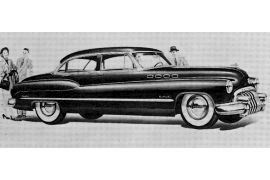 |
 |
Buick Roadmaster |
| |
Also see: Buick Car Reviews | The History of Buick |
| |
Buick offered 22 models, seven Series 40 Specials, seven Series 50 Supers and eight top-line Series 70 Roadmasters. The latter had four 'port holes', the others only had three. All had 8-in-line OHV engines with hydraulic valve lifters and CID was 248, 263 and 320. Prices ranged from US$1803 to $3433. Buick became the fourth manufacturer to produce more than half a million cars in one year (552,857) and no less than 429,903 of these had the relatively new Dynaflow torque-converter transmission. Pictured left is the Roadmaster Sedan, Model 72. |
|
 |
 |
 |
Buick Roadmaster Station Wagon |
| |
Also see: Buick Car Reviews | The History of Buick |
| |
1950 Buick Roadmaster Station Wagon. Roadmasters produced between 1936 and 1958 were built on Buick's longest wheelbase and shared its basic structure with senior Oldsmobiles. Between 1946 and 1957, the Roadmaster was Buick's premium and best appointed model, and was offered in sedan, coupe, convertible and station wagon bodystyles between 1936 and 1948. The 1953 Buick Roadmaster station wagon, Model 79-R, was the last wood-bodied station wagon mass-produced in the United States. Its body was a product of Iona Manufacturing which built all Buick station wagon bodies between 1946 and 1964. Priced at US$4,031, the wagon was second in price to the Buick Skylark. Only 670 of these final woody wagons were produced for 1953. |
|
 |
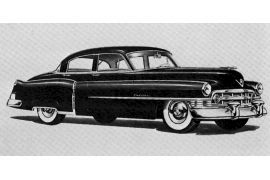 |
 |
Cadillac |
| |
Also see: Cadillac Car Reviews | The History of Cadillac |
| |
In 1950 Cadillac produced over 100,000 cars for the first time in its history. There were four lines - Series 61 (122 inch wheelbase), Series 62 (126 inch wheelbase) Series 60S (130 inch wheelbase) and Series 75 (146¾ inch wheelbase, eight passenger), as well as a 163 inch wheelbase ambulance chassis (86). All models had a 331 CID V8 engine with hydraulic valve lifters and most were available with Hydra-Matic drive. |
|
 |
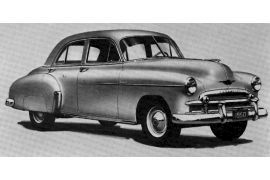 |
 |
Chevrolet |
| |
Also see: Chevrolet Car Reviews | The History of Chevrolet |
| |
For 1950 Chevrolet sold the Series 2100HK Styleline DeLuxe Sedan, Model 2103. Two and four door sedans were also available with fastback (Fleetline DeLuxe Models 2152 and 2153 resp). Austere versions of most Chevrolet models were in the 1500HJ Special Series. All had the familiar valve-in-head Six engine of 216 CID (235 CID when equipped with the new Powerglide auto transmission). That year, Chevrolet reached the highest production volume by any auto maker in history with 2,108,273 units. In December the 25 millionth Chevy was made. |
|
 |
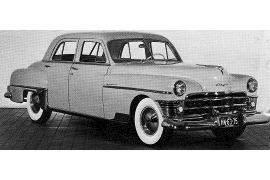 |
 |
Chrysler New Yorker |
| |
Also see: Chrysler Car Reviews | The History of Chrysler |
| |
Chrysler offered two series of New Yorker's in 1950, the C-48 with 125½ inch wheelbase dubbed the Royal Windsor, and the C-49 with 131½ inch wheelbase available in Saratoga, New Yorker, Town & Country iterations. Engines were 250 6L CID and 323.5 CID Straight Eight respectively. |
|
 |
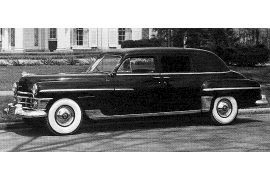 |
 |
Chrysler Imperial |
| |
Also see: Chrysler Car Reviews | The History of Chrysler |
| |
Chrysler also offered the Crown Imperial Series C-50, with custom built body by Derham. This was one of the ultimate American luxury automobiles, boasting a 145½ inch wheelbase and 323.5 CID Straight Eight engine. |
|
 |
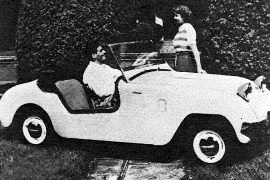 |
 |
Crosley |
| |
Also see: Crosley Car Reviews | The History of Crosley |
| |
To avoid confusion with the British Crosley concern, the American Crosley was known in some countries as the Crosmobile. The model VC Roadster had an 85 inch wheelbase, while the CD Sedans and Wagons had an 80 inch wheelbase. All were fitted with the same 44 CID 4 cylinder engine. |
|
 |
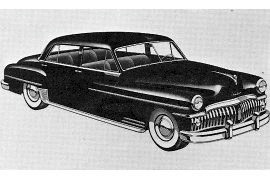 |
 |
DeSoto |
| |
Also see: The History of DeSoto |
| |
DeSoto had two ranges for 1950, the S-14 DeLuxe and Custom (pictured left), both with 236.7 CID L-Head Six engines and a 139½ inch wheelbase, 8 and 9 seat passenger models and a taxi. For export markets, there was also a smaller SP-20 Diplomat - which was basically a Plymouth. |
|
 |
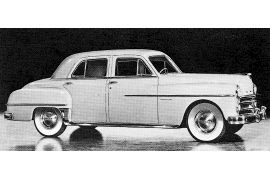 |
 |
Dodge |
| |
Also see: Dodge Car Reviews | The History of Dodge |
| |
The Dodge Coronet D-34 was the top-line model, on a 123½ inch wheelbase. Other series included the Kingsway D-36 (for export markets), Wayfarer D-33 (115 inch wheelbase) and meadowbank D-34 (123½ inch wheelbase). All had L-head Six engines. In the Coronet line there was also a 137½ inch wheelbase 8 passenger sedan. |
|
 |
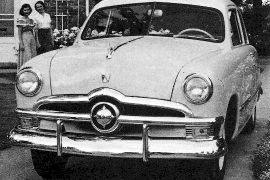 |
 |
Ford |
| |
Also see: Ford Car Reviews | The History of Ford |
| |
Ford offered the 95 bhp Six (OHA) and 100 bhp V8 (OBA) ranges, both with 114 inch wheelbases, in each range there were basic (DeLuxe) and more luxurious (Custom) models, and a variety of body styles. Pictured left is the Series OHA Six DeLuxe Tudor two door sedan Model 70A. |
|
 |
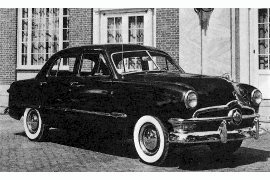 |
 |
Ford |
| |
Also see: Ford Car Reviews | The History of Ford |
| |
Ford series OBA V8 Custom Fordor (four-door-sedan) Model 73B. Ford fitted the 239.4 CID V8 100 bhp L-head engine. A special 110 bhp engine was available for law enforcement agencies. During 1950 a luxury Tudor, named the "Crestliner" was announced. Like the Convertible, it was available only with a V8 engine. |
|
 |
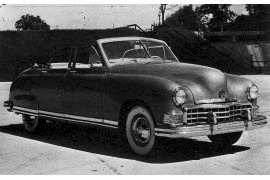 |
 |
Frazer |
| |
|
| |
The 1950 Frazer models were the same as for 1949, comprising a four-door sedan Model F505 with a list price of US$2254, a luxurious Model F506 Manhattan Sedan at $2446 and the vehicle pictured left, a convertible version of the Manhattan Sedan costing US$3110. All were mechanically similar to the Kaiser. |
|
 |
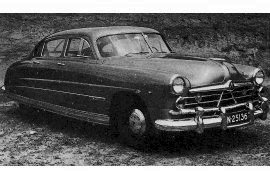 |
 |
Hudson Super Six |
| |
Also see: The History of Hudson |
| |
Hudson produced three ranges for 1950, the Pacemaker (500) and Pacemaker DeLuxe (50A) on a 119 inch wheelbase and fitted with a 232 CID engine. There was a Super Six (501) and Eight (503) on a 124 inch wheelbase with 262 and 254 CID engines respectively. The top-of-the-line was the Commodore Six (502) and Eight (504) with wheelbase and engines as Super Six and Eight. All had the 'step-down' Monobilt body-cum-frame design with recessed floor as introduced in 1947 and in-line L-head engines. Pictured left is the Super Six Sedan. |
|
 |
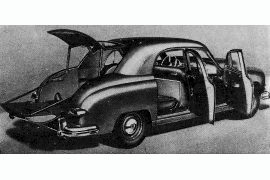 |
 |
Kaiser |
| |
Also see: Kaiser Car Reviews | The History of Kaiser |
| |
The Kaiser offerings were the same as for 1949: four door six-seaters with 123½ inch wheelbases and Continental 226.2 CID L-head Six engine. Models ranged from a four-door convertible at US$3016 down to the Special Sedan at US$1874. Included were the K501 Traveler (pictured left) and K502 Vagabond (DeLuxe) sedan-shaped utilities. Entirely new models were released in May, 1951. |
|
 |
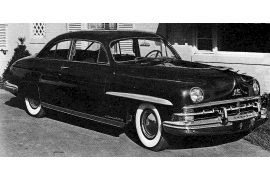 |
 |
Lincoln |
| |
Also see: Lincoln Car Reviews | The History of Lincoln |
| |
The Lincoln Cosmopolitan Series OEH had a 336.7 CID L-head V8 and 125 inch wheelbase. There was a two-door coupe (pictured left), convertible and sedan available. The lower-priced OEL with 121 inch wheelbase was available in Coupe and Sport Sedan models. |
|
 |
 |
 |
Mercury |
| |
Also see: Mercury Car Reviews | The History of Mercury |
| |
The 1950 Mercury Series OM models were facelifted 1949 models. Again there was a coupe (body type #72, pictured left) a Sport Seday (body type #74), a convertible (body type #76) and a station wagon (body type #79). Of the Coupe there were now Standard (#72A), DeLuxe (#72B) and Custom (#72C) variants. All had a 118 inch wheelbase chassis and 255.4 CID flat-head V8 engine. The French Ford Vedette had similar styling features. |
|
 |
 |
 |
Meteor |
| |
|
| |
The Meteor (pictured left) and Monarch were produced in Canada for their domestic market, as well as the American market. Both iterations were based on US Ford and Mercury respectively but came with a different grille and trimfeatures. |
|
 |
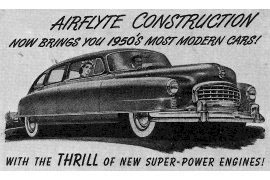 |
 |
Nash Airflyte |
| |
Also see: Nash Car Reviews | The History of Nash |
| |
Nash offered the Rambler (with 100 inch wheelbase Station Wagon and Convertible), Statesman (with 112 inch wheelbase DeLuxe, Super and Custom) and Ambassador (121 inch wheelbase Super and Custom). All had Airflyte styling with enclosed front wheels, a 1949 to 1956 Nash design feature. |
|
 |
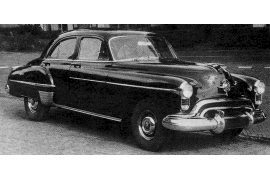 |
|
 |
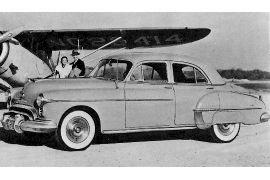 |
 |
Oldsmobile Series 88 Futuramic |
| |
Also see: Oldsmobile Car Reviews | The History of Oldsmobile |
| |
The Series 88 Futuramic Sedan was in Olds' medium range. It was very similar to the Series 76, but the engine was a 303.7 CID V8. Top line models were in Series 98. These had the same V8 engine but a 112 inch wheelbase and larger body. All models could be ordered with Hydra Matic Drive and most were. Total 1950 production was 396,757 cars, including the three-millionth since 1897! |
|
 |
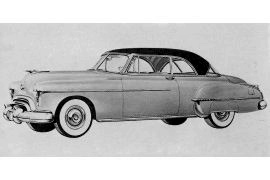 |
 |
Oldsmobile Series 88 Futuramic DeLuxe Holiday Coupe |
| |
Also see: Oldsmobile Car Reviews | The History of Oldsmobile |
| |
The Oldsmobile Series 88 Futuramic DeLuxe Holiday Coupe featured a Fisher hardtop body which was also used by the Chevrolet Bel Air and Pontiac Catalina. The wheelbase was 119½ inches. |
|
 |
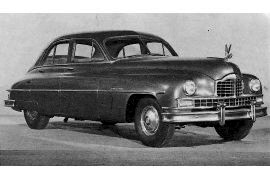 |
 |
Packard |
| |
Also see: Packard Car Reviews | The History of Packard |
| |
Packard produced their 23rd Series from May 1949 until the summer of 1950. There were various wheelbase sizes, 8 cylinder in-line engines and body styles. Some had ultramatic automatic transmission, in addition there was an export only Six on a 120 inch wheelbase and a New York style taxicab with the same 245 CID engine but on a 141 inch wheelbase. Pictured left is a DeLuxe Super Eight Sedan with 127 inch wheelbase and a 327 CID engine. |
|
 |
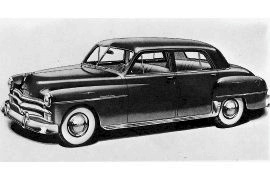 |
 |
Plymouth |
| |
Also see: Plymouth Car Reviews | The History of Plymouth |
| |
Plymouth offered various body styles in three series: the P-19 DeLuxe with 111 inch wheelbase and P-20 DeLuxe and P-20 Special DeLuxe (pictured left), both with 118½ inch wheelbase. DeSoto and Dodge dealers in certain export territories sold the same car with distinguishing radiator grilles as the Diplomat and Kingsway respectively. All had 217.8 CID 97 bhp L-head Six engine and were similar in most respects to 1949 production. |
|
 |
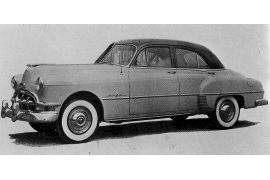 Pontiac Chiefrain
Pontiac Chiefrain |
 |
Pontiac |
| |
Also see: Pontiac Car Reviews | The History of Pontiac |
| |
The Pontiac Silver Streak chieftain four-door Sedan was available in both the Series 25 Six (239.2 CID) and the Series 27 Eight (268.4 CID). Engines were in-line L-heads. Of coupes and sedans there were fastback versions named Streamliner. New for 1950 was the Catalina Hardtop Coupe. The wheelbase of all models was 120 inches, and Hydra Matic Drive was optional. |
|
 |
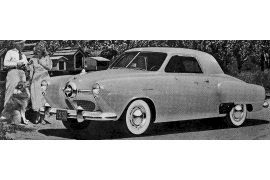 |
 |
Studebaker |
| |
Also see: Studebaker Car Reviews | The History of Studebaker |
| |
The 1950 Studebaker models had a restyled from end and new coil spring front suspension replacing the transversal leaf type. Pictured left is the Model 9G-Q1 Champion 3 passenger DeLuxe Coupe which had a 113 inch wheelbase and 85 bhp 169.6 CID L-head Six engine. Fivv passenger coupes, two and four-door sedans and a convertible were also available. |
|
 |
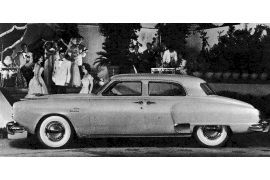 |
 |
Studebaker |
| |
Also see: Studebaker Car Reviews | The History of Studebaker |
| |
The Studebaker Commander Land Cruiser Model 17A-Y5 was the top-of-the-line sedan. Mechanically similar to other Commanders, its wheelbase was four inches longer at 124 inches. The engine was a 102 bhp 245.6 CID L-head Six. All Champion body styles were available also on the 120 inch wheelbase Commander chassis. |
|
 |
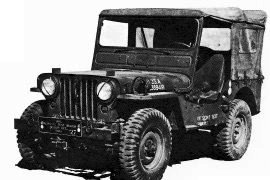 |
 |
Willys |
| |
Also see: Willys Car Reviews | The History of Willys |
| |
Willys produced the famed Universal Jeep CJ3A as well as a wide range of Jeep inspired models, including Jeepster Phaetons, Station Wagons and Pickups. Some types were available with either conventional (4 x 2) or all-wheel-drive (4 x 4). For use in the Korean war, the US Army ordered a military version of the CJ3A and a substantial number of these (designated Truck ¼ ton 4 x 4 Utility M38 were built during 1950-1952. One such example is pictured at left. |
|
 |
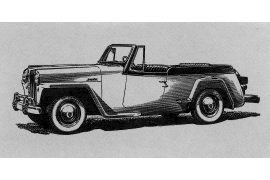 |
 |
Willys Jeepster Phaeton |
| |
Also see: Willys Car Reviews | The History of Willys |
| |
The Willys Jeepster Phaeton, styled by Brooks Stevens, was first introduced in May 1948. In 1950 it was avaiilable with either the 134 CID four or 161 CID Six engine. The Wheelbase was 104 inches. |
|
|
